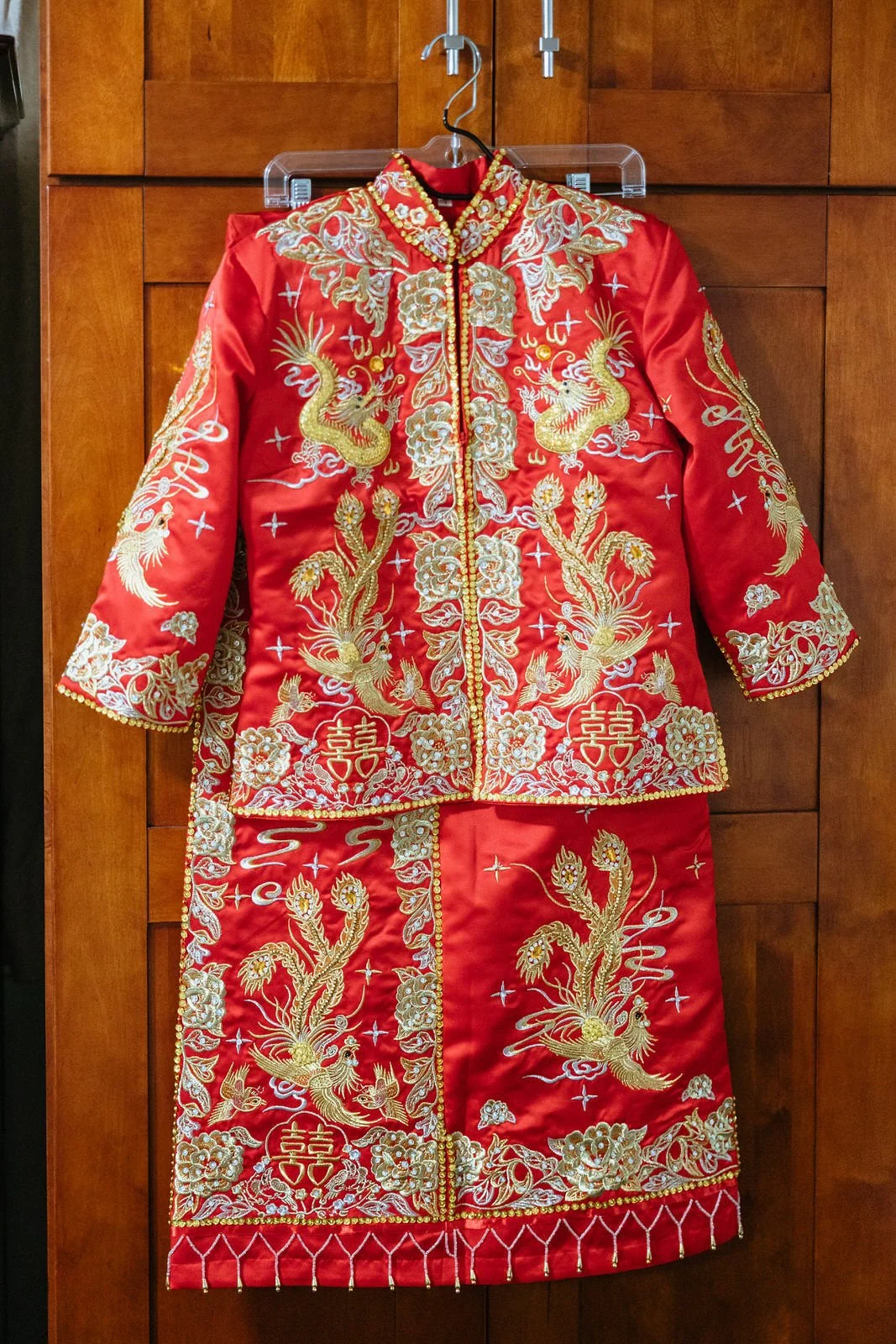Traditional Vietnamese and Chinese Tea Ceremony 101
🫖 Vietnamese vs. Chinese Tea Ceremony Traditions: A Guide for Newly Engaged Couples
If you're newly engaged and planning a Vietnamese, Chinese, or multicultural wedding, you're likely discovering the deep cultural traditions that accompany your big day. Among the most meaningful is the tea ceremony — a sacred moment that honors family, celebrates unity, and pays tribute to generations past.
Though both Vietnamese and Chinese tea ceremonies are rooted in respect and gratitude, their customs, symbolism, and presentation are beautifully distinct. In this guide, we’ll walk you through the essentials of both traditions — from the ceremonial attire to the meaning behind the red tray gifts — so you can thoughtfully incorporate them into your wedding celebration.
A Meaningful Start: The Tea Ceremony in Asian Weddings
In East Asian cultures, tea is more than a beverage — it’s a symbol of harmony, tradition, and reverence for elders. For Vietnamese and Chinese families, the tea ceremony is a treasured wedding ritual where the bride and groom express gratitude to their parents and ancestors.
Often held on the wedding day, this ceremony is not only a cultural formality, but also an emotional exchange filled with blessings, gifts, and heartfelt moments between generations. As a couple begins their new life together, this ritual connects the past, present, and future — one cup of tea at a time.
The Vietnamese Tea Ceremony (Lễ Rước Dâu)
In a Vietnamese wedding, the tea ceremony typically takes place during the bride procession, known as Lễ Rước Dâu. The groom’s family formally visits the bride’s home, bringing elaborately decorated red trays (called mâm quả) filled with symbolic gifts. These offerings are exchanged between families, followed by the serving of tea to both sets of elders.
During the ceremony:
The bride and groom wear traditional attire: the bride in a vibrant red áo dài, and the groom in an ornate áo gấm.
Tea is usually a delicately scented green tea, often with lotus or jasmine.
As tea is offered, elders return blessings, advice, and gifts like gold jewelry or red envelopes.
The setting is adorned in auspicious red and gold, symbolizing happiness and prosperity.
This moment isn’t just ceremonial — it’s deeply emotional, often marking the first formal meeting between two families.
The Chinese Tea Ceremony (敬茶 – Jìng Chá)
In a Chinese wedding, the tea ceremony (Jìng Chá) is a sacred expression of filial piety and family unity. It’s typically held on the wedding day, either before the banquet or immediately after the couple's official marriage registration.
Unlike the Vietnamese ceremony, the Chinese tea ritual follows a stricter order. The couple serves tea to the groom’s family first, followed by the bride’s family, typically kneeling or bowing while presenting the tea — a profound gesture of respect.
The bride may wear a qipao or Hanfu, and the tea is traditionally Oolong, Jasmine, Pu’er, or Tieguanyin.
Elders receive the tea and offer “lucky money” in red envelopes (hóngbāo), along with blessings and sometimes heirloom jewelry.
It is a quiet, respectful, and often emotional moment of honoring lineage and receiving approval from the family.
The Chinese wedding tea ceremony is a deeply rooted custom that blends spiritual values, family hierarchy, and celebration — all in one elegant ritual.
The Symbolic Red Tray (Mâm Quả) in Vietnamese Weddings
One of the most visually striking elements of a Vietnamese wedding is the red tray procession, or mâm quả. These round lacquer trays, often wrapped in red cloth and carried by members of the groom’s family, contain carefully selected gifts that symbolize prosperity, fertility, and respect.
Here are some of the most common red tray items and what they represent:
Betel leaves and areca nuts: Symbolize traditional love, fidelity, and family bonding
Tea leaves or tea boxes: Represent purity, respect, and the wish for a harmonious marriage
Sticky rice cakes (Bánh phu thê): Signify loyalty, unity, and sweetness in the relationship
A selection of five fruits: Typically dragon fruit, bananas, apples, oranges, and grapes — each chosen for luck and abundance
A roasted pig: Symbolizes prosperity and respect for the bride’s family, often included in Southern Vietnamese weddings
Candies and sweets: Represent joy and a sweet life together
Wine or rice liquor: Toasts to celebration and lasting happiness and of course, Cognac!
Red envelopes with gold or jewelry: Signify wealth, security, and blessings for the couple
Incense and candles: Used to pay tribute to ancestors, creating a spiritual connection on the wedding day
Traditionally, Vietnamese families use even numbers of trays (like 4, 6, or 8), as even numbers are associated with balance and harmony. In some parts of Northern Vietnam, odd numbers may be preferred, reflecting local customs.
Key Differences Between Vietnamese and Chinese Tea Ceremonies
While both traditions share the same spirit of honoring family and unity, there are a few key differences that set the Vietnamese and Chinese tea ceremonies apart:
In Vietnamese weddings, tea is served to both families during the same ceremony, while Chinese weddings typically begin with the groom’s family first.
The red tray tradition (mâm quả) is central to Vietnamese ceremonies, while Chinese weddings often focus more on red envelopes, symbolic fruits, and pastries like lotus seed buns or wife cakes.
Vietnamese couples usually stand while serving tea, while in Chinese culture, couples kneel or bow to show deeper reverence.
The tea selections differ, with jasmine-scented green tea common in Vietnam and stronger teas like Oolong or Pu’er preferred in China.
Attire also reflects regional style — from the elegant flowing áo dài in Vietnam to the richly embroidered qipao or Hanfu in China.
These subtle but meaningful differences give each ceremony its own beauty and character, allowing couples to honor their cultural heritage in a way that feels personal and authentic.
Planning Your Tea Ceremony: Blending Traditions
For many modern couples — especially those from multicultural backgrounds — blending elements from both ceremonies can be a beautiful way to represent both families.
You might choose to:
Incorporate Vietnamese red trays with Chinese tea rituals
Use elements from each family’s region or dialect group (such as Hokkien, Cantonese, or Northern Vietnamese customs)
Wear both traditional outfits during different parts of the day
Include personal touches, like serving a tea blend that reflects your story or shared heritage
There’s no one “right way” — what matters most is that the ceremony is meaningful to you and your families.
Lion Dancers
Lion dancers at the tea ceremony bring an electrifying and symbolic start to the wedding festivities, blending cultural tradition with high energy and celebration. Their vibrant costumes, rhythmic drumming, and dynamic movements are believed to ward off evil spirits and bless the couple with happiness, prosperity, and good fortune. As they dance through the ceremony space—often weaving between guests and interacting playfully—the lions not only honor the couple’s heritage but also create an unforgettable, joyful atmosphere that sets the tone for the day.
Final Thoughts: Honoring the Past, Celebrating the Future
The tea ceremony — whether rooted in Vietnamese or Chinese wedding traditions — is one of the most moving parts of the wedding day. It goes beyond photos and aesthetics. It’s a moment to pause, give thanks, and receive the love and blessings of the generations who came before you.
As you plan your wedding, take time to understand the symbolism of the red tray, the meaning behind the tea you serve, and the emotions that will fill the room as you kneel (or stand) in front of your parents. It may be one of the most unforgettable parts of your journey into married life.















